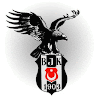 Bringing back memories of NASA's early successes, this logo dates back to 1959, when the National Advisory Committee on Aeronautics (NACA) metamorphosed into an agency that would advance both space and aeronautics: the National Aeronautics and Space Administration (NASA). After a NASA Lewis Research Center illustrator's design was chosen for the new agency's official seal, the head of Lewis' Research Reports Division, James Modarelli, was asked by the executive secretary of NACA to design a logo that could be used for less formal purposes. Mr. Modarelli simplified the seal, leaving only the white stars and orbital path on a round field of blue with a red airfoil. Then he added white N-A-S-A lettering.
Bringing back memories of NASA's early successes, this logo dates back to 1959, when the National Advisory Committee on Aeronautics (NACA) metamorphosed into an agency that would advance both space and aeronautics: the National Aeronautics and Space Administration (NASA). After a NASA Lewis Research Center illustrator's design was chosen for the new agency's official seal, the head of Lewis' Research Reports Division, James Modarelli, was asked by the executive secretary of NACA to design a logo that could be used for less formal purposes. Mr. Modarelli simplified the seal, leaving only the white stars and orbital path on a round field of blue with a red airfoil. Then he added white N-A-S-A lettering. In the "meatball" design, the sphere represents a planet, the stars represent space, the red chevron is a wing representing aeronautics (the latest design in hypersonic wings at the time the logo was developed), and then there is an orbiting spacecraft going around the wing.
Known officially as the insignia, NASA's round logo was not called the "meatball" until 1975, when NASA decided a more modern logo was in order and switched to the "worm"--a red, stylized rendering of the letters N-A-S-A.
The use of "meatball" for "any combination of raw or cooked meat shaped into balls" dates back much farther, at least to 1838 (the Oxford English Dictionary's oldest citation). An 1877 recipe used mutton and veal necks, but variously seasoned meatballs had been known by other names in other cultures. There were spicy Greek keftedes containing minced veal, onions, herbs, and breadcrumbs; olde English pome-dorries (dating back to at least A.D. 1381) made of beef and egg yolks or pork liver and flour; and the much loved Italian and Swedish meatballs (whose ethnic names I could not find in time for this article). "Meatball" has also been used for a dull, unattractive person and for a penant for battle efficiency or an athletic scholarship.
The use of "meatball" in aeronautics also predates NASA's round insignia, but not by much. In 1957, the U.S. Navy referred to a "meatball of light" in its procedure for landing aircraft on aircraft carriers: "The mirror reflects a bright light astern and upward into a beam which the pilot follows straight to a landing by keeping the "meatball" of light precisely centred in the mirror."1 This eventually became known as the meatball landing system.
In 1992, Administrator Dan Goldin brought NASA's meatball back from retirement to invoke memories of the one-giant-leap-for-mankind glory days of Apollo and to show that "the magic is back at NASA." Lewis' hangar and publications now reflect this change. But nostalgia has its price.
When the "meatball" was designed in 1959, printing was a completely photographic process. Photocopiers were just beginning to be available, and their quality was too poor for printing; no one was even dreaming of digital printing.
"It's a design nightmare," sighs Greg Patt, Graphics Manager for Lewis' Publishing Services contractor, Cortez III. "It doesn't print well on laser printers because of the gradations on the airfoil, and it can't be used at less than 5/8 inch because the stars disappear and the type becomes illegible."
It is hard to match the meatball's blue background on color copiers, and the lettering and airfoil do not contrast enough on black & white copiers. Because of its dark blue background, two versions are used: the basic version is used against light backgrounds and that version surrounded by a thin white line is used against dark backgrounds. In addition, its round shape makes it difficult to artfully place type around or near it--something that the more rectangular "worm" was suited for. Such limitations were unimportant with photographic printing because a negative of the logo had to be stripped (cut and taped) into a negative layout, so smaller sizes would have been impractical, printers wanted to avoid stripping in small chunks of type, and gradations in shading or hue were produced easily.
Reference:http://history.nasa.gov/meatball.htm













0 yorum:
Post a Comment